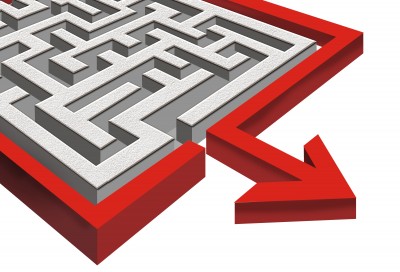
Who goes there?
In any retail environment, a slice of your traffic will be nothing more than browsers. They have no money, no way to pay or intent to purchase. They’re just looking. The problem is, most online retailers overestimate the size of this slice. Not everyone who leaves your site without purchasing is a deadbeat. Were they scared away by your registration process? Did they get lost? Did they need to see more product details? Dismantle the barriers and watch the number of abandonments shrink.
What Environment Have You Created?
If online commerce were simple, we’d all be on a beach drinking pina coladas through rolled-up cash. Unfortunately, simply building a website isn’t enough. Thoughtful consideration must be given to design and navigation structure. Skeptical? As any sales experts will tell you, every purchase is made within an environment; great products, price and service will not overcome a poorly designed environment. In the late-90s, we recall trolling around on a government surplus auction site. The products were desirable, if you could bear to dig through the multiple levels of sub-menus, reference numbers and category lists. Because of the confusing navigation, auction closing prices on this site were usually lower than market value, evidenced by the items selling a few days later on Ebay at a much higher price. The point: an unpleasant and puzzling site will choke your stream of prospective customers, eliminating all but a brave few. What do people do when they are confused? They hesitate, they lose confidence and they begin to disengage. Intent to purchase fades with each unsure click. If your shopper is frustrated or disoriented, they’ll leave. This has been proved and quantified during the last century of brick and mortar retail but it applies even more acutely online, where entry and exit are nearly effortless.
Price functions on a similar curve. More shoppers will tolerate clumsy navigation if your prices are discounted deeply. The danger online, however, is that your bargain-basement competitor will build a more elegant site than yours. After all, building a good site does not necessarily cost more than building an awful site. However, using price to control demand is an obvious and direct hit to your bottom line.
What Are Your Elements of Design
Effective online retail design utilizes visual coherence and simplicity rather than decorative or striking elements. Many non-retail sites, for example architectural firms, generally aren’t based on use – their aim is to display and impress. Inversely, Amazon.com is an online retail behemoth for a host of reasons, but edgy site design isn’t one of them.
That doesn’t mean your retail site should be the equivalent of a pair of tan slacks. Retailers can and should build a sense of brand identity and consistency using well-chosen and applied design elements.
- Dimensionality is one technique that adds interest and is often employed in menu bars – layering, mimicking stacks of paper or ribbons give shoppers subtle visual cues that can aid navigation by more clearly identifying different pages, functions or operational areas within the site. A light hand is best; brash or overly emphasized elements fall flat.
- A subtle shift in a clicked element is a great use of JavaScript animation, whereas rotating menus and fly-outs could either distract or repulse.
- Well-designed icons impart meaning, engagement and brand identification. Overuse of icons or decoupling them from text can lead to a phenomenon called “mystery meat” in which your visitors have to guess what that button does.
- Similarly, a few speech balloons might be a good thing, but 10?
What did I click?
Good retail site design walks the line between giving obvious information and giving too much; If a page only has two or three buttons, simply changing the color of one when it is clicked is not going to do the trick. Design for the sake of decoration leads to clutter. Web design elements are best employed when they allow your shoppers to see where they are, what they can access, how to get there. Further, they ought to find what they want easily, whether or not they have to go to another page.
Reward your shoppers with great, solid design and they will reward you in turn.
InteractOne designs and builds e-commerce websites, with a whole-site approach that emphasizes content, SEO and capturing meaningful data. In business since 1998, InteractOne scales its approach to fit the needs of a range of clients from start-ups to Fortune 500 stalwarts.
Great tutorial.Thanks for sharing your experience with ecommerce site design, nodoubt it could convert browsers to buyers.Looking forward for more postings.
I also think this is a well written tutorial that anyone can learn from, especially i found number 3 important, and i often find sites where you have no clue what buttons do/ or take you.
Thanks
This was really an interesting article. It has been seen that a custom designed e Commerce site reflects your individuality, builds customer confidence, creates a memorable shopping experience, and converts browsers into buyers. Thank for sharing.
My knowledge about ecommerce website design can be improved a lot and your article helped me with it. I can certainly use this information to become more professional in ecommerce websites.
I am very glad this content was available. It’s very thought provoking, informative and easy to read and understand. I know this information will be very helpful for me in the future.
Great key points to create eCommerce site design by understanding the environment created,elements of design and every other things explaining this……..
Thanks for sharing your experience with ecommerce site design.
thanks for sharing valuable message…………..
I am very glad this content was available to me it will help me in designing my site more efficiently.
Very good information. I would agree people tend to focus too much on traffic and not enough on conversations. By laying out these tips it will help with these conversions.